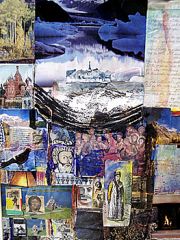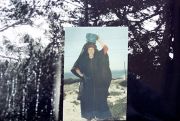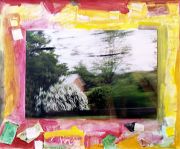Carolyn Berry
I make many forms of art - paintings in acrylics and in watercolor enhanced with pencil and Chinese white; carvings in balsa wood, sometimes painted; sculptures from poly form, a form of plastic that is baked in the oven. As well, I make assemblages from natural objects such as gourds and wasps nests which I combine with manufactured objects: dolls, doll furniture, mirrors, rocks, beautiful knotted yarn from France, antique tools, marbles and lead soldiers!
A unique form I developed is collaged books, some of which are autobiographical. These are constructed from old school books I found that were dog-eared, mice-nibbled, and scribbled on and colored-in by children. Some books had been covered with cloth by mothers trying to save the book from another child in the family. The collaged book is a perfect medium for re-creating trips, allowing the artist to utilize collected and treasured scraps: labels, photos, stickers. One book, "The Everyday Devil," has covers onto which folk-art objects made for the Day of the Dead are sewn with bright thread.
Another medium I have been using the past few years is photography. I take many pictures of everyday life: my granddaughter's new polka dot dress, blooming plants, traffic accidents and other sights on trips, weather, family events, friends. These I show by simply putting them into boxes, for viewers to shuffle through, to experience an artist's view of ordinary life.
I have been fortunate to have good role models of women artists. My great-aunt Mildred Walker traveled and studied on the East Coast and Europe in the late 1800's. When she came back to Missouri, she taught china painting and French at a college until her sight became too poor. Her works are greatly treasured by the family.
Another great-aunt, Ada Harrison, was an oil painter. Dependent on a married sister for a home, she destroyed most of her work when she thought her sister was going to die and she would be displaced. These women artists inspired me, but I also knew they had a hard time of it.
In my family, art was a natural part of life. My mother was a good photographer of her family and made wonderful costumes for us children. My grandmother Berry was a quilter and I delighted in sorting the pieces and smoothing them with my fingers. I made paper dolls and cloth dolls, carved and painted soap, made towns out of bakers clay and a doll house out of an orange crate. In high school I painted a mural for the teen center and had a two-person show.
My first art instructor in college was an independent, knowledgeable woman who, seeing how inexperienced and shy I was, introduced me to quality art materials and let me find my own way. I was not to find such tolerance at the University of Missouri, where I subsequently studied. The art department there was split between the New York school and the regionalists. The very demanding instructor who led us into abstract expressionism preached Art; he said we should only take art classes and, if we wanted to be serious artists, we would have to move to New York.
One of the young male painters made me an offer: we would go to the fabled city where I would work and support him as well as take care of the house. I refused. The lifestyle of the abstract expressionists in New York - a male life centered on baseball games and boozing in bars - was not for me. The few women artists had a hard time of it and those who had children mostly gave them to relatives to raise. I was determined to have a family life and be an artist as well, and eventually I did. I married another artist who was also a professor, with whom I had two daughters, and we alternated between California and New York.
I have always supported my art, rather than the other way around, because I wanted to be independent and able to criticize myself and not repeat for the sake of the market. In spite of this, I have been successful - I have been in Who's Who in American Art since the '70s and have shown all over the U.S., as well as abroad.
Presently, I am working on large 3' x 7' acrylic paintings, on which I spend a lot of slow time, looking and planning more and repainting less; I no longer slash and wipe as much as in the abstract expression days. The painting of one of these large canvases, The Baby's Dream," parallel my daughter's pregnancy: it contains elements of a nativity - a mother birthing, father and animals watching, and over all, the profile of the successfully birthed baby, my new granddaughter.




